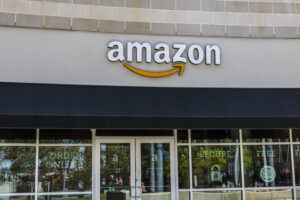
Amazon is planning to open several large department store-style shops in America, marking a fresh assault on bricks-and-mortar retailing by the technology giant.
The online retailer, which has recently overtaken Walmart as the biggest seller of clothes and footwear in the US, is planning to open shops of around 30,000 sq feet — about a third of the size of a traditional department store. They will make their debut in Ohio and California, according to The Wall Street Journal, which first reported the plans.
Amazon’s department stores are expected to feature its own private-label fashion brands, which include Lark & Ro for officewear, Cable Stitch for knitwear, Mae lingerie and Core 10 activewear. At a recent Congressional hearing with Jeff Bezos into Amazon’s treatment of third-party brands, it was revealed that 9 per cent of Amazon’s clothing sales are its own labels. It also sells its own furniture, batteries and electronic devices, although it is thought the new shops would likely feature some of its most popular local marketplace brands.
The decision to open department stores follows Amazon’s move into physical retailing after opening bookstores in Seattle in 2015, its $13.4 billion acquisition of grocers Whole Foods and the launch of cashierless stores, known as Amazon Go in the US and Amazon Fresh in the UK. It now operates in nearly 100 locations in the US under different brands; these include 31 4-Star shops, which feature only products rated four stars or higher by customers.
Amazon opened its first till-free grocery shop in the UK in March in Ealing, west London, and now has five dotted around the capital. In a further indication of its bricks-and-mortar ambitions, Amazon poached Tesco stalwart Tony Hoggett last month to run its global physical store network — a move that shocked the industry and raised expectations of a further landgrab.
Natalie Berg, founder of the NBK retail consultancy and author of Amazon, said it would want to open clothing stores to capture more of a market where the majority of shoppers still frequent shops. Prior to the pandemic, 80 per cent of clothes shopping was done in physical stores.
Industry observers have highlighted the recent high number of US retail casualties and falling footfall as making the cost to Amazon of opening stores significantly cheaper, as property owners are now willing to agree to more affordable and flexible terms.
Amazon entered a new chapter this summer when founder Jeff Bezos stepped aside as chief executive for Andy Jassy, a company veteran. Bezos remains executive chairman.
After a record year during the pandemic, the group’s dominance of online retail shows little sign of dwindling. It reported net product sales of $58 billion in the latest quarter, up some 15 per cent.
Bricks-and-mortar chains have meanwhile started to benefit from recovering footfall as more consumers return to high streets. Macy’s and Kohl’s, two leading US department store chains, today upgraded their annual sales forecasts.
Read more:
Amazon gets physical with department stores launch

